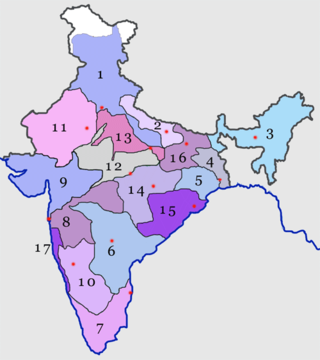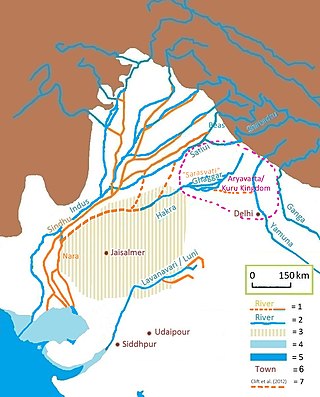
Jodhpur is the second-largest city in the Indian state of Rajasthan and officially the second metropolitan city of the state. Jodhpur was historically the capital of the Kingdom of Marwar, which is now part of Rajasthan. Jodhpur is a popular tourist destination, featuring many palaces, forts, and temples, set in the stark landscape of the Thar Desert. It is popularly known as the "Blue City" among people of Rajasthan and all over India. It serves as the administrative headquarters of the Jodhpur district and Jodhpur division.

The North Western Railway is one of 19 railway zones in India. It is headquartered at Jaipur, Rajasthan and has 59,075+ employees, 658+ stations and a route length of more than 5,761 kilometres (3,580 mi) across the states of Rajasthan, Gujarat, Punjab and Haryana. NWR operates international rail service Thar Express from Jodhpur to Karachi. This zone is the key enabler of the Delhi–Mumbai Industrial Corridor Project by virtue of running railways 1,500 km long Western Dedicated Freight Corridor.

Marwar is a region of western Rajasthan state in North Western India. It lies partly in the Thar Desert. The word 'maru' is Sanskrit for desert. According to the Rajasthani languages, In “Marwad” word “wad” means “defense” and “Maru” means “desert“, so the meaning of “marwad” is, “A country protected by desert“.

The Luni is the largest river in the Thar Desert of northwest India. It originates in the Pushkar valley of the Aravalli Range, near Ajmer, passes through the southeastern portion of the Thar Desert, and ends in the marshy lands of Rann of Kutch in Gujarat, after travelling a distance of 495 km (308 mi). It is first known as Sagarmati, then after passing Govindgarh, it meets its tributary Sarasvati, which originates from Pushkar Lake and from then on it is called Luni.
Gorwar or Godwar, is a region of Rajasthan state in India, which lies in the southwest Rajasthan and borders with the state of Gujarat.
Pali is a city and capital division in Rajasthan state of India. It is the administrative headquarters of Pali District. It is on the bank of the river Bandi and is 70 km (43 mi) south east of West Jodhpur. It is known as "The Industrial City".

Nagaur District is one of the 50 districts of the state of Rajasthan in western India. Panchayati Raj was introduced here. It is the fifth largest district in Rajasthan and the area of the district is 17,718 km2 (6,841 sq mi). The city of Nagaur is the district headquarters.

Jawai Bandh is a dam built across the Jawai River, a tributary of Luni River, in Rajasthan.
Sumerpur is a city in the south part of Pali District of Rajasthan state in India. Named after Maharaja Sumer Singh of Jodhpur, it came into existence in 1912 on the northern bank of Jawai river. The town is headquarters of the Sumerpur revenue subdivision and Sumerpur Tahsil. Sumerpur is an important agricultural mandi for Pali, Sirohi and Jalore districts.
Marwar Junction is a census town and tehsil headquarter in Pali district in the Indian state of Rajasthan. This is an important railway junction on Ahemdabad - Delhi mainline in Pali district.
Rani is a town and municipality and tehsil of Pali district in the Indian state of Rajasthan. It lies on the banks of Sukri River, a tributary of the Luni River. It is an important railway station on Ahmedabad-Delhi railway line. Some nearby villages are Beejowa,Itendra Medtian,etc.
Sojat Road is a census town in Sojat tehsil of Pali district in the Indian state of Rajasthan. Sojat Road train station is located on Ajmer-Marwar Junction route and the most convenient method of traveling is by train.
The origin of Jawai river is in the hills of Goriya village of Bali town, located on the border of Pali and Udaipur districts.
The roads' detail of Pali district is as given below.
Sumerpur Tehsil is one of the 10 tehsils in the Pali district of Indian state Rajasthan.
Bagrinagar or Bagri is a village and gram Panchayat in Sojat tehsil of Pali district of Rajasthan state in India.
Gaguda is a village located in the Sojat Mandal, Pali District, in the Indian state of Rajasthan. Gaguda is 14.2 kilometres (8.8 mi) from its Mandal Main Town Sojat.
Marwar Junction railway station is located in Pali district in the Indian state of Rajasthan. It serves the census town at Marwar Junction.
Pali Marwar railway station is a major railway station in Pali district, Rajasthan. Its code is PMY. It serves Pali Marwar city. The station consists of two platforms, neither of which is well sheltered. It lacks many facilities including water and sanitation.
SardarSamand, is a lake formed by dam built across the Sukri river and Guhiya Nala, which are tributaries of Luni River. It was built with the cost of around 8 Lakhs rupees and was named after the Maharaja of Jodhpur, Sardar Singh. Its construction started in 1899 and completed in 1905–06. It is situated in Pali district of Rajasthan.












